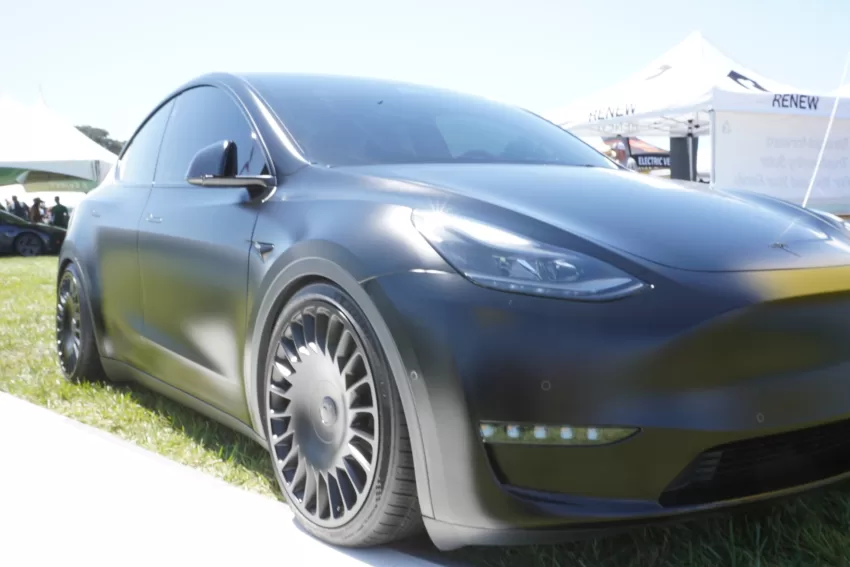When discussing the electric vehicle (EV) market, it’s impossible to overlook the colossal impact of Tesla. The electric vehicle market, propelled by advancements in technology and a shift towards sustainable energy, has grown exponentially in the last decade with Tesla leading the way. And yet, nearly a decade later, few automakers have made as much progress as Tesla either in engineering and sales.
Recent data underscores this dominance: In the first quarter alone, Tesla’s Model Y sales soared to 267,200 units, eclipsing the sales of Toyota Corolla, which stood at 256,400. An impressive number dwarfed only by the Q1 unit sales of nearly a half million total Tesla EVs sold. This is following a strong trend of electrification with more models released every year from automakers, and an uptick in consumer adoption.
This achievement becomes even more impressive when juxtaposed against other market heavyweights such as Toyota’s Hilux, RAV4, and Camry. But Tesla’s prowess isn’t limited to just the EV sector. With their advancements in off-grid solar solutions and cutting-edge AI-driven self-driving technology, they’re poised to redefine multiple industries.
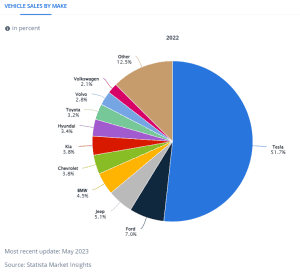
Yet, while Tesla’s achievements are undeniably impressive, there are other contenders in the market worth considering. Let’s delve into a comparative analysis.
The electric vehicle (EV) market is experiencing a surge of power, with a significant increase in market share and sales volume. As of 2023, EVs have captured a market share of 14.5%, a significant leap from the previous years. The total sales volume of EVs has also seen a substantial increase, with 5.4 million units sold in 2023.
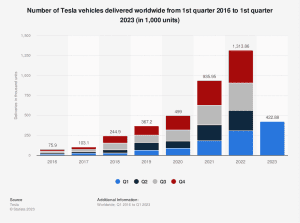
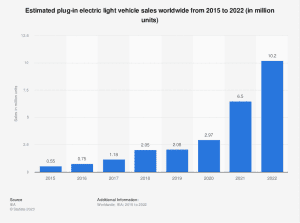
The National Automated Vehicle Standards Committee (NASC) has been instrumental in setting standards for electric vehicles, ensuring safety and efficiency in the burgeoning EV market. The NASC standard has played a pivotal role in shaping the EV market, providing guidelines for manufacturers and ensuring the safety of consumers.
Tesla, a leading player in the EV market, has been making waves with its innovative strategies including opening its patents to the public, allowing other manufacturers to use its technology in good faith. This decision, announced by CEO Elon Musk in 2014, was made in the spirit of the open-source movement and aimed at advancing electric vehicle technology. Tesla’s decision not to initiate patent lawsuits against anyone who wants to use their technology in good faith has been a game-changer, encouraging more manufacturers to venture into the EV market.
The EV giant also launched a pilot program in November 2021 to open its Supercharger network to non-Tesla EVs. This initiative is part of Tesla’s mission to accelerate the world’s transition to sustainable energy. The Supercharger network, which boasts more than 45,000 Superchargers worldwide, is now accessible to non-Tesla EV drivers in some countries. This move is expected to encourage more drivers to switch to electric vehicles, further boosting the EV market. EV automakers are just now beginning to announce charging partnerships.
“Ford, GM, Nissan, Mercedes-Benz, Polestar, Rivian, and Volvo announced this summer that their vehicles will be able to use Tesla’s Superchargers starting in 2024, and EV experts expect more automakers to follow suit,” per consumer reports and X.
But how do you know which vehicle is right for you? We’ve gathered some of the data for you in an easy to understand table. Please keep in mind that this information, while accurate to the best of our knowledge, isn’t guaranteed and you’ll need to double check with the manufacturer in all cases as this information, especially pricing, is subject to change. Also keep in mind that most EVs, like standard combustion engine cars, come with many bells and whistles which can greatly increase the price of the car, but these are also offset by EV tax incentives.
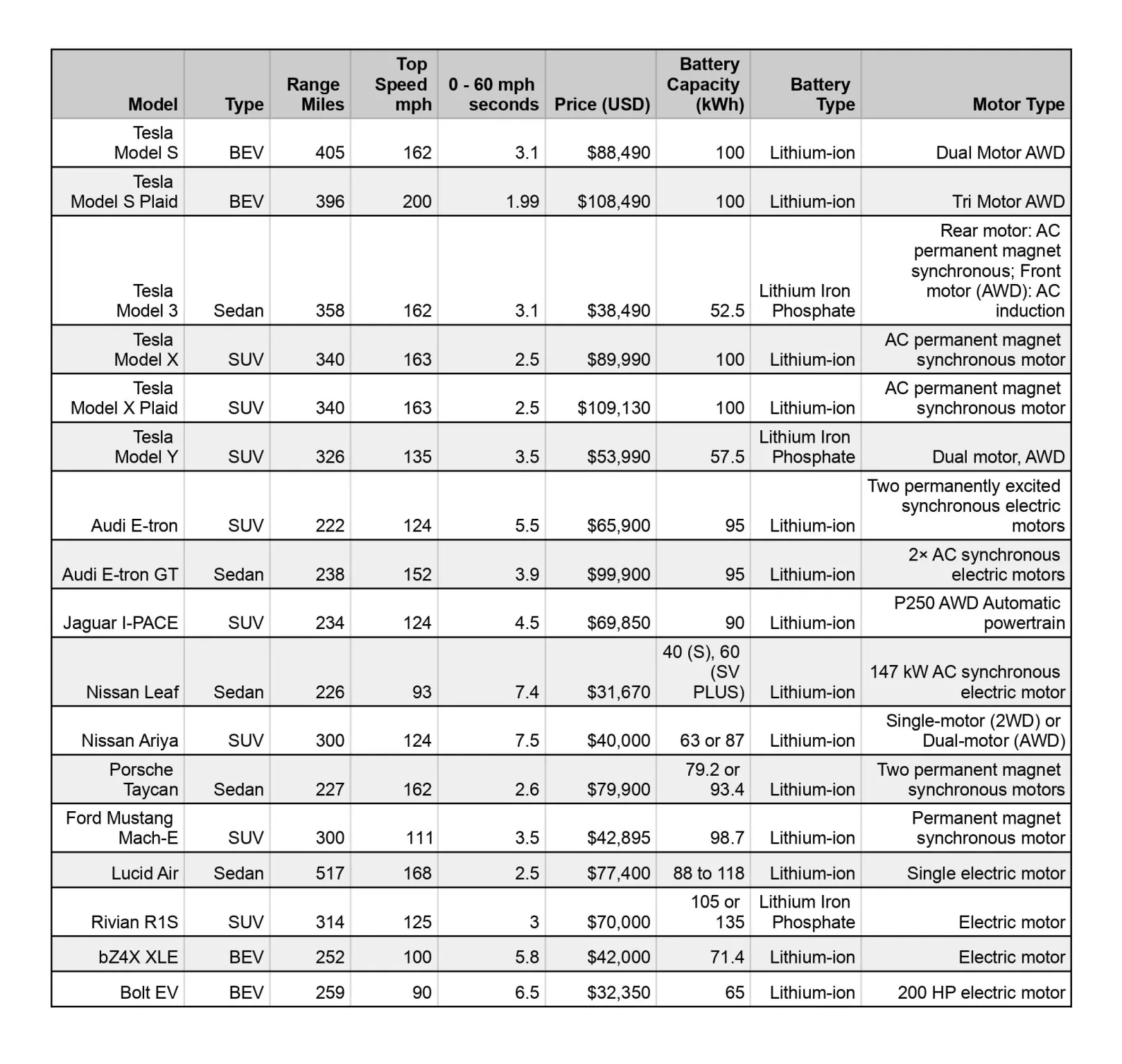
Most EV batteries in the US are Lithium-ion based, requiring both nickel and cobalt. In 2021 Tesla moved to a Lithium Iron Phosphate based battery, ““LFP has both positive and negative trade-offs … It’s significantly cheaper and doesn’t require any nickel or cobalt. It’s also more stable, which makes it safer … One major downside: The cells are less energy-dense, which means they offer lower range for the same weight as other cells. Cold weather also affects them more,” per CNBC.
How do you choose?
If you are looking at a reliable fully electric vehicle with consistent performance, options, and service, Tesla seems to take the cake. Having spent the better part of a year researching Tesla and the electric vehicle market, it’s clearly superior in many ways, including price and overall lifetime vehicle cost.
In fact, you might struggle to place the other vehicles. Having paid attention to the EV market for years like many environmentalists, I thought the Chevy Bolt or Nissan Leaf would dominate the market, I have yet to see either on the road but I can’t leave my house without seeing a Tesla. Forget about any of the other models that might only be found at car shows. And if you’re looking for innovation you might not find it for a while outside of Tesla, most automakers are struggling with the software required to maintain and control an EV. Many, like one future Ford EV, might just replicate the tesla guts with Ford body, personal communication with Robert Scoble tech journalist in X spaces discussion.
Apart from style, cost, and performance, many potential EV shoppers will also want to consider the source and cost of their electricity. In Oregon we’re fortunate to largely be fueled by the Columbia River and the associated wind in the gorge. Our coal fired power plants are shutting down, and we don’t have significant public solar or nuclear power plants. In places like California it might make sense to include a solar roof or array to charge your vehicle while Oregon residents west of the Cascades might never get enough sun to return the investment in the panels.
If you travel significantly, supercharger stations are often powered by solar, so it’s possible to charge your vehicle entirely on the sun or other renewables. If you live in an area where this isn’t the case you might consider waiting until the footprint of the new vehicle is offset by charging with renewable energy (we’re getting close!). As more manufacturers enter the market and more consumers opt for electric vehicles, the EV market is set to continue its upward trend, driving towards a sustainable future.
But what consumers should *really* be paying attention to is the automation of EVs. That’s something we’ll be diving into in a future article on robotics.

